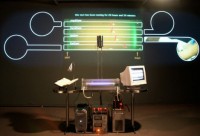PAUL VANOUSE
Latent Figure Protocol
source: paulvanouse
Latent Figure Protocol takes the form of a media installation that uses DNA samples to create emergent representational images. The installation includes a live science experiment, the result of which is videotaped and repeated for the duration of the gallery exhibit. Employing a reactive gel and electrical current, Latent Figure Protocol produces images that relate directly to the DNA samples used. The above images were re-produced live. Each performance lasts approximately one hour, during which time audience members see the image slowly emerge.
In the first experiment, a copyright symbol is derived from the DNA of an industrially-produced organism (a plasmid called “pET-11a”), illuminating ethical questions around the changing status of organic life and the ownership of living organisms. Future instances of the LFP will use the DNA of other subjects and create other images.
.
.
.
.
.
.
.
source: creative-capitalorg
Latent Figure Protocol is a media installation that uses DNA samples to create representational visual art works. Like many of Paul Vanouse’s projects, the process begins with a live science experiment, the result of which is videotaped and repeated for the duration of the gallery exhibit. Employing a reactive gel and electrical current, Latent Figure Protocol produces images that relate directly to the DNA samples he employs. In one, a copyright symbol is derived from the DNA of genetically modified crops, illuminating ethical questions around the changing status of organic life and the ownership of living organisms. Vanouse’s computer simulation software that make generating images for this project easier. He’s also expanding his image repertoire to include more metaphorical images, i.e. planes or birds.
Working at the crossroads of genetics and art, Paul Vanouse has been creating interdisciplinary installations since 1990. His work has been exhibited widely in the United States and international venues including the Museo Nacional de Bellas Artes in Buenos Aires, Argentina; the Louvre in Paris; and the TePapa Museum in Wellington, New Zealand. He is featured in the book Information Arts by Stephen Wilson and has been funded by the Pennsylvania Council on the Arts, The New York State Council on the Arts, The New York Foundation for the Arts, and the Heinz Foundation, among others. He is an associate professor of art at the University at Buffalo in New York and has also taught at the University of California, San Diego.


